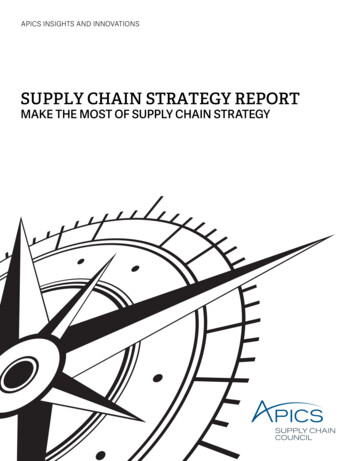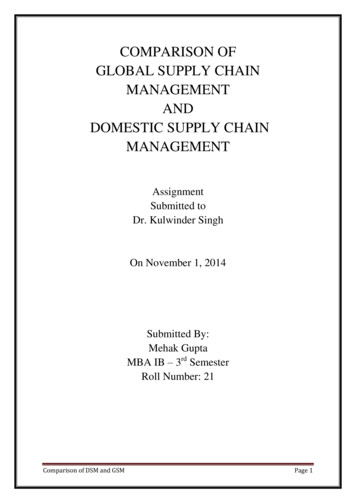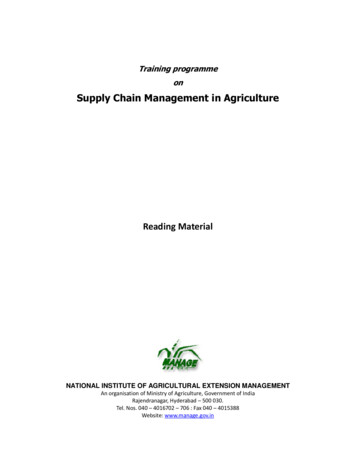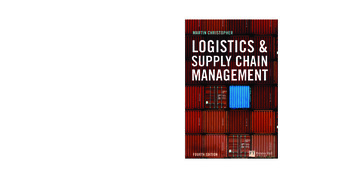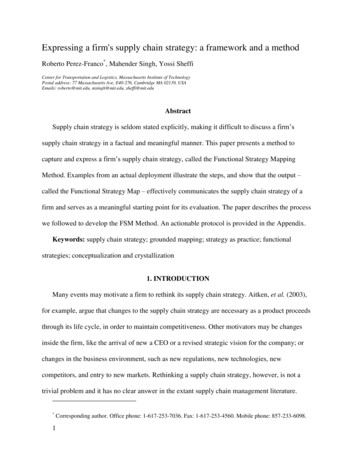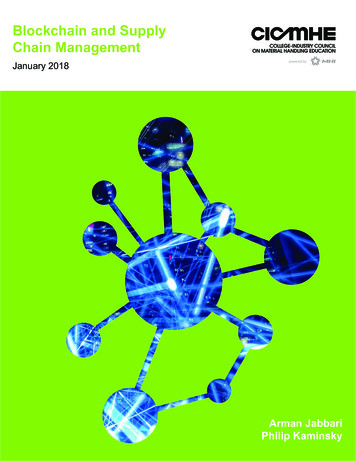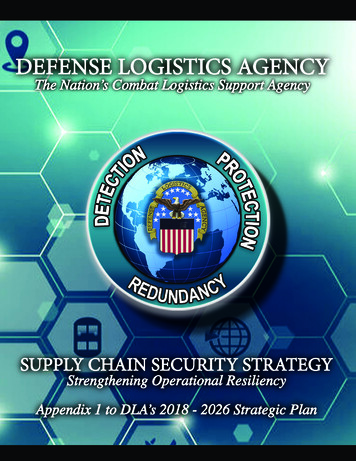
Transcription
DEFENSE LOGISTICS AGENCYThe Nation’s Combat Logistics Support AgencySUPPLY CHAIN SECURITY STRATEGYStrengthening Operational ResiliencyAppendix 1 to DLA’s 2018 - 2026 Strategic Plan
DEFENSE LOGISTICS AGENCYMESSAGE FROM THE DIRECTORDLA’s Supply Chain Security Strategy is the roadmap for how the Agency willaddress supply chain security challenges across the enterprise. This cross-cutting effortis fundamental to our operations and underpins DLA’s ability to support the Warfighter.Interruption of DLA supply chain operations compromises our nation’s ability to delivercombat power and execute critical missions. It’s that serious!As the nation’s Combat Logistics Support Agency responsible for end-to-endmanagement of nine supply chains supporting the Warfighter, DLA has an inherentimperative to ensure we have the proper detection, protection, redundancy and resiliencebuilt into our systems, processes, infrastructure and people to ensure continued supportto the Warfighter.Today’s world presents a multitude of challenges to DLA’s supply chainoperations. Threats from natural disasters, geopolitical developments, nefariousactivities, diminishing manufacturers, and the ever-present threat from the cyber-domaindemand that DLA continues the journey to strengthen operational resiliency. As thethreat environment evolves, so too must DLA’s ability to detect, protect, and continueoperations in a contested or degraded environment through redundant and resilientsupply chain operations.This document carves a path forward for the Agency to follow in pursuitof strengthening operational resiliency across the enterprise. The strategy withinit anchors to the fundamental elements of Supply Chain Risk Management (SCRM)and Mission Assurance. I need every DLA member to understand this strategy and tosupport it wherever you may fit in because supply chain disruption is not an option forthe Warfighter. With each of us synchronized on supply chain security, together we canthwart disruption by strengthening operational resiliency.Warfighter First!i2www.dla.milDarrell K. WilliamsLieutenant General, US ArmyDirector, Defense Logistics Agency
TABLE OF CONTENTSMESSAGE FROM THE DIRECTOR.iSTRATEGIC CONTEXT. 2DLA’S GLOBAL SUPPLY CHAIN. 2THREAT SPECTRUM. 2DESIRED END STATE. 2SUPPLY CHAIN SECURITY ARCHITECTURE. 3THREAT/VULNERABILITY IDENTIFICATION ANDRISK PRIORITIZATION. 3OFFENSIVE RISK MITIGATION. 3DEFENSIVE RISK MITIGATION. 3RESILIENT SUPPLY CHAIN OPERATIONS. 3PREVENT, DETECT, PROTECT AND DEFEND. 3SUPPLY CHAIN SECURITY STRATEGICFOCUS AREAS. 4INSTITUTIONALIZE SUPPLY CHAIN SECURITY. 4MAINTAIN INTEGRITY AND ACCESS TO KEY DATA. 5PARTNER WITH REPUTABLE VENDORS. 6STRENGTHENING RESILIENCY. 6LEVERAGING ENTERPRISE ENABLERS. 8CONCLUSION. 9Warfighter First!Defense Logistics Agency Supply Chain Security Strategy1
STRATEGIC CONTEXTDELIVER UNCOMPROMISED“Today our adversaries may have a better understanding of our strategic vulnerabilities than do we. This includesvulnerabilities introduced via networks or through the supply chain. This is because of poor/inadequate intelligence on suchthreats, excessive compartmentation that precludes effective sharing of such threat information, lack of prioritization, andwidespread availability of information in the public domain.”- MITRE Report, 8 Aug 2018, Strategy for Supply Chain Security and Resilience in Response to the Changing Character of Warability to supply DLA critical parts for the Warfighter for anextended period of time. Geopolitical developments haveWhile speaking at the HQ CIA Supply Chain Summit in Aprilthe potential to constrain DLA’s access to allied partners,2019, the Joint Staff Director for Logistics observed thatvendors, and critical resources. The proliferation of sensitivethe character of logistics has changed dramatically overinformation by the unintentional mishandling of exportthe years, but the nature of logistics remains the same.controlled technical data can lead to an adversary’s abilityGetting the right things where they need to be at the rightto intercept US military technology. Bad-actors engagingtime and in serviceable condition has always been thein nefarious activities can steal theprimary objective. However, in the currentidentity of legitimate suppliers, introducetechnology-enabled environment, “theSUPPLY CHAIN SECURITYcounterfeit parts into DLA’s Global Supplyway” logisticians accomplish that is veryVS. SCRMChain, and disrupt the Agency’s financialdifferent compared to the past. Today’sposition. Sole-source and diminishingsupply chains are expansive, non-linear,Supply Chain Security is DLA’smanufacturers can ground fleets ofcomprehensive approach toand highly relationship-dependent. DLA’saircraft if they choose to discontinueprotect supply chains, keyGlobal Supply Chain is staggeringlyoperations while foreign dependenciesinfrastructure and critical assetsexpansive and consists of Acquisitions,and lack of visibility into sub-tier suppliersin order to assure uninterruptedStorage, Distribution, and Disposal primarycan lead to additional counterfeiting,delivery of proactive globalmission-sets. It extends to 46 states andcyber-attack, and espionage.logisticsinpeaceandwar.28 countries and encompasses a myriadof complex and interconnected systems,Supply Chain Risk ManagementDESIRED END STATEprocesses, facilities, infrastructure,(SCRM) is the process forDLA’s mission is to sustain Warfightersuppliers, transportation nodes, endmanaging risk by identifying,readiness and lethality by deliveringusers, and employees. Twenty-threeassessing and mitigating threats,proactive global logistics in peace andsub-elements enable these primaryvulnerabilities and disruptionswar. Maintaining an effective supplyto the DOD supply chain fromcomponents of DLA’s Global Supplybeginningtoendtoensuremissionchain security posture through SupplyChain. They include business processes,effectiveness.Chain Risk Management (SCRM) isbusiness systems, distribution centers,DODI4140.01fundamental to the Agency’s ability tovendor-networks, industrial support,meet its mission. It is within the threatfinancial health, employee readiness,spectrumcapturedabove that DLA must innovate tocybersecurity, DLA’s six Major Subordinate Commands andstrengthenoperationalresiliency in support of the Warfighter.nine supporting supply chains. Each of these supply chainDLAmustcontinuouslyidentify, assess, report and mitigatecomponents and sub-elements are susceptible to adversarialthreats,vulnerabilities,anddisruptions to its Global Supplyexploitation and disruption from a host of potential threats.Chain. DLA’s end state is to establish an enterprisearchitecture that comprehensively addresses supply chainTHREAT SPECTRUMsecurity challenges. An architecture that evolves as newCyber-attacks are a continuous threat to DLA’s Globalthreats emerge, one that endures the test of time andSupply Chain due to the interconnectedness of ourprovides uninterrupted support to the Warfighter.information technology-dependent operations. Thereare more electronic devices than people in DLA, andcyber-attackers are growing in their sophistication. Eachyear there are millions of attempts to access sensitiveinformation on the DoD network. However, the threatspectrum extends far beyond cyber-attacks. Natural andman-made disasters and accidents can disrupt a vendor’sDLA’S GLOBAL SUPPLY CHAIN2www.dla.mil
DLA’S SUPPLY CHAIN SECURITY ARCHITECTUREWhat does a “secure” global supply chain look like? DLA’soverall supply chain security strategy is designed toestablish an architecture that comprehensively addressessupply chain security from an enterprise perspective. Thearchitecture consists of five broad components. Thesecomponents are depicted in Figure 1 and explained in thefollowing 5 paragraphs:RESILIENT SUPPLY CHAIN OPERATIONSThe fourth architectural component is the guarantor ofuninterrupted support to the Warfighter. Its purpose is toinfuse resiliency into DLA’s systems, processes, infrastructureand people. In the event that an adversary or natural disasterthreatens DLA’s Global Supply Chains, resilient supplychain operations ensure the mission continues. Examplesof resiliency include redundant capabilities, continuity ofoperation plans and systems hardening.PREVENTION THROUGH DETECTION,PROTECTION AND DEFENSETHREAT/VULNERABILITY IDENTIFICATION ANDRISK PRIORIZATIONThe first architectural component is foundational to theAgency’s supply chain security strategy. Its purpose is toestablish a repeatable process to identify and report threatsand vulnerabilities across DLA’s expansive Global SupplyChain and to prioritize associated risk. To strengthenoperational resiliency, DLA must first understand where the“soft-underbellies of logistics” are within the Agency. Thisfirst architectural component does that. The process mustbe comprehensive, repeatable and continuous, given theemergent and ever-changing nature of threats.OFFENSIVE RISK-MITIGATION SOLUTIONSThe second architectural component is dependent upon thefirst. Once threats are identified, DLA must have the abilityto develop innovative offensive mitigating solutions thatattack and minimize those threats. Examples of offensivesolutions include market-intelligence, cyber-operations andDNA-marking of microelectronics.DEFENSIVE RISK-MITIGATION SOLUTIONSSimilarly, once vulnerabilities are identified, DLA musthave the ability to develop innovative defensive solutionsthat protect vulnerabilities and mitigate risk. Examples ofdefensive solutions include Business Decision Analytics,Vendor Network Mapping and Export Controlled TechnicalData Supplier Validation Processes.The purpose of the fifth architectural component is tooperationalize supply chain security within the Agencyand to ensure that it endures the test of time. DLA mustcontinuously prevent disruption by integrating supply chainsecurity into the Agency Synchronization and OperationsCenter business rules in order to effectively detect,report, protect and defend against emergent threats. TheAgency must also fully integrate SCRM into DLA’s MissionAssurance portfolio and ultimately into the EnterpriseRisk Management framework to ensure that supply chainsecurity is addressed from an enterprise perspective.DID YOU KNOW?DNA Marking of Microelectronics: To counterthe growing sophistication of counterfeiters,DLA launched an anti-counterfeiting program toimprove delivery time, reduce costs, strengthensupply chain controls and enhance qualityassurance. DNA marking consists of applyinga botanical DNA identifier to the surface ofa microcircuit to authenticate originality. TheDNA mark cannot be replicated and deterscounterfeiters. A hand-held scanner for easyidentification within the supply chain can detectthe DNA mark. The mark can also be used forforensic testing by providing detailed informationabout the microcircuit, such as supplier, CAGEcode, part and lot number.Vendor Network Mapping: Relationships inDLA supply chains are complex. However, DLAis employing a powerful tool to map vendornetworks from Tier 1 through Tier 3 supplierscalled Vendor Network Mapping. This capabilitymakes it possible to look upstream in vendornetworks to identify risks in areas such as vendorfinancial position, compliance, legal and foreignrelationships.Defense Logistics Agency Supply Chain Security Strategy3
SUPPLY CHAIN SECURITY STRATEGIC FOCUS AREASTo create an architecture that comprehensively addressessupply chain security from an enterprise perspective, DLAwill concentrate on the following four Strategic Focus Areas: Institutionalize Supply Chain Security across theDLA enterprise Maintain integrity and access to key data Partner with valid, reputable vendors who producequality supplies and services Strengthen the resiliency of systems, processes,infrastructure and peopleThe Strategic Focus Areas represent “strategy bins” thathouse supply chain security-related initiatives, which aremapped to objectives within DLA’s 2018-2026 StrategicPlan. Those objectives are depicted in Figure 2 as indicatedby the purple circle labeled with an “S” ( ).4www.dla.milThe supply chain security initiatives are the essence ofDLA’s overall supply chain security strategy. They put thestrategy into motion by actuating the four Strategic FocusAreas for the purpose of achieving an architecture thatcomprehensively addresses DLA’s supply chain securitychallenges. The next four sections takes a closer look ateach of them.INSTITUTIONALIZE SUPPLY CHAIN SECURITYACROSS THE DLA ENTERPRISEThe first Strategic Focus Area underwrites DLA’s ability toexecute its Mission Essential Functions during peace andwar, regardless of the nature of disruption. The bedrockinitiative within this Strategic Focus Area is integratingSupply Chain Security into the Agency’s Mission Assuranceportfolio and Enterprise Risk Management framework.Key and essential to this is developing a standardized,repeatable process to assess enterprise-wide supply chain
vulnerabilities. Establishing such a process is foundationalto DLA’s ability to identify and report vulnerabilities andto prioritize, manage and mitigate supply chain risk. Thisinitiative also unequivocally assigns the Office of PrimaryResponsibility for Supply Chain Security to DLA J3, LogisticsOperations. Explicit ownership of this cross-cutting effortenables an integrated approach to securing DLA’s GlobalSupply Chain.This Strategic Focus Area also includes an initiativeto finalize the development of the Agency’s ResilientSupply Chain Operations Scorecard which will providea “live” operational view of DLA’s Supply Chain Securityenvironment. The Scorecard includes DLA’s primary supplychain components and 23 sub-elements and portraysthem from an Agency, Major Subordinate Command andRegional Command perspective. This live-fed resource willbe integrated into DLA’s Enterprise Dashboard which willallow the Agency Synchronization and Operations Center toproactively prevent supply chain disruption through detection,protection and defense of DLA’s Global Supply Chain. Theinitiative takes a phased approach to implementation by first(Phase I) developing the initial concept and business rulesfor its use. Phase II then incorporates existing feeds withinthe Enterprise Dashboard for an initial live-view and Phase IIImaps the remaining feeds and fully integrates the completedScorecard into the Enterprise Dashboard.MAINTAIN INTEGRITY AND ACCESS TO KEY DATAThe second Strategic Focus Area includes two primaryinitiatives that protect data and network systems. The firstone is designed to protect the Agency’s data and systemsfor internal use by operationalizing DLA’s CybersecurityStrategy. Data and system breaches can cause significantdisruption to supply chain operations. They are often timesmore difficult to detect and counter and can undermineconfidence in the data or system in ways other disruptionsdo not. This initiative operationalizes DLA’s deployment oflayered cybersecurity activities to protect, defend and infuseresiliency into information technology systems. Maintaininga secure and resilient cyberspace operating environmentand ensuring prioritized remediation of top cyber risksare essential components of this initiative. It also sets inmotion an effort to explore strategic partnerships betweenDLA and US Transportation and Cyber Commands toprovide integrated, secure supply chain solutions to DoD.The Global Supply Chain is as strong as its weakest link.Because of this, strategic alignment among these partnersis critical to ensure cyber-secure transitions between DLAsupply chain operations and USTRANSCOM mission sets.The second initiative strengthens Operations Security(OPSEC) practices by controlling the exportation of DLA’sdata to external partners through various measures. Muchof DLA’s data is sensitive in nature. Military specificationsand standards, technical data packages (TDP), schematics,customer delivery destinations and many other forms ofexportable data are subject to exploitation if in the wronghands. This initiative strengthens technical data controlsacross the enterprise by instituting an enhanced validationprocedure for suppliers requiring access to export controlledtechnical data and develops the capability to block foreignInternet Protocol addresses from accessing export controlleddata stored in DLA’s data repository. This initiative alsoassigns the highest level of restriction to the data repositoryfor exportable data that includes a TDP and minimizes theamount of time a TDP is made available in the repository.Defense Logistics Agency Supply Chain Security Strategy5
CONTINUED SUPPLY CHAIN SECURITY STRATEGIC FOCUS AREASA third initiative within this Strategic FocusArea optimizes the use of cybersecurityas a discriminator in source selectionsand awards to ensure DLA conductsbusiness with vendors who take appropriateaction to protect DoD sensitive data andinformation. The Agency will also continue itscollaborative partnerships with academia andindustry to share Supply Chain Security bestpractices and innovations with an emphasison cybersecurity and data protection.OPERATIONS SECURITYDLA will also continue its collaborativeefforts to enhance the Agency’scapabilities to protect against counterfeitparts and supplier fraud through existingcross-functional working groups. Threein particular provide tremendousopportunities for functional area experts toengage at the enterprise level to addressthe counterfeit/fraud problem-set; theTechnical Quality (TQ) - Distribution FraudCouncil, the TQ - Trade Security FraudCouncil and the Procurement WorkingPARTNER WITH VALID, REPUTABLEGroup. Discovery from these workingVENDORS WHO PRODUCE QUALITYgroups will be captured in a revisedSUPPLIES & SERVICESversion of DLA Instruction 4000.04,Counterfeit Materiel Prevention andThe purpose of the third Strategic Focus AreaMitigation. DLA is also in the processis to ensure that the vendors DLA partnersof developing enhancements to DLA’swith produce high-quality materiel for theInternet Bid Board System (DIBBS) toWarfighter. The accompanying initiatives arestrengthen the Agency’s capabilities toheavily focused on preventing counterfeitmitigate counterfeit and fraud risk whenand non-conforming parts from enteringprocuring parts from an independentinto DLA’s Global Supply Chain. With welldistributor as opposed to a trusted supplierestablished processes in-place to ensurewithinDLA’sexistingvendor base. DLA also established aDLA partners with valid and reputable vendors, fraudulentmarketintelligenceinitiativedesigned to give the Agency aexploitation still exists given the sheer volume of in its vendorbusiness transactions and the automation required entsupport them. Further complicating this is the complexity ndsub-vendor relationships that support DLA’s primary vendordisseminatingactionableintelligenceforbase. DLA has limited insight into thesespecific markets of interest to help shaperelationships which often times have severalacquisition strategies.upstream providers, foreign dependenciesBUSINESS DECISIONand a multitude of potential entry points forANALYTICScounterfeit and non-conforming parts to enterSTRENGTHEN RESILIENCYDLA uses a decision supportinto DLA’s Global Supply Chain.OF SYSTEMS, PROCESSES,To protect against counterfeit parts andfraudulent vendor activity, DLA engagesin a number of mitigating activities. First,the Agency will continue to “DNA mark”trusted-source microcircuits through DLA’sProduct Test Center for Electronics in orderto positively identify integrated circuit cardsthroughout their life cycle. The Agency willalso refine and implement vendor networkmapping tools and Business DecisionAnalytics platforms to help identify subvendor relationships and enhance DLA’sability to report suspect counterfeit activity tothe Defense Criminal Investigation Service.Operations Security (OPSEC)is a systematic process topreserve friendly essentialsecrecy by identifying,controlling and protectingcritical information andindicators that would allowadversaries or potentialadversaries to identify andexploit friendly vulnerabilities.DLA must be ever vigilantwhen handling logisticsinformation and must protectit at all times, especiallywhen interacting with itsvendor network. Each DLAorganization maintains CriticalInformation and IndicatorsLists that identify unclassifiedbut sensitive informationthat must be protected fromdisclosure.tool called Business DecisionAnalytics (BDA) to analyzenearly 1 million bids a day tohelp mitigate procurementrisk. BDA is part of a suiteof tools that use machinelearning, predictive variables,multiple data sources andadvanced analytics to helpmake informed material andpurchasing decisions byevaluating supplier, solicitation,price and item risk. BDA helpsDLA mitigate risk when makingmaterial and purchasingdecisions.INFRASTRUCTURE AND PEOPLEThe fourth Strategic Focus Area ensuresDLA’s support to the Warfighter continueseven in the midst of disruptive activity.The supporting initiatives were developedto strengthen operational resiliency bybuilding resiliency into the Agency’ssystems, processes, infrastructure andpeople. The hallmark initiative withinthis Strategic Focus Area is designed tomake the Agency’s supply chains resilientto all hazards and threats. To achievethis, DLA will enhance supply chainresiliency by continuing to provide worldclass protection to its employees andOPSEC is everyone’s job!6www.dla.mil
infrastructure. These two critical supply chain resourcesof DLA’s supply chains for the purpose of strengtheningare key and essential to successful supply chain operations. operational resiliency.Facilities must be secure and reliable and employees mustContinuity of operations is a key aspect of this Strategicbe able to detect and prevent disruptions and spring intoFocus Area and to the Agency’s overallaction to provide continued operations whenSupply Chain Security Strategy becausedisruptions occur. DLA will also strengthenWHAT’S THEit ensures uninterrupted support to theresiliency in its infrastructure by reducingDIFFERENCE?Warfighter during disruptive events. DLAcyber risks to installations and critical facilityhas extensive continuity of operationscontrol systems through the developmentResiliency: Defines theplans (COOP) that underwrite the Agency’sof an inventory, assessment and mitigationability to recover, convergeMission Essential Functions. The plansor self-heal to restore normalprogram for mission critical control systems.range from broad enterprise-wide missionoperations after a disruptiveareas, to Major Subordinate Command/DLA will also strengthen operationalevent.supply chain problem-sets and process/resiliency by exploiting current andsystem-specific mission areas. DLAemerging technologies that optimizeRedundancy: Idefines theensures continuity of operations throughsupply chain risk identification, analysisdeployment or provisioning ofdevolution/relocation plans and backand reporting through internal andduplicate devices or systemsup processes for key systems andin critical areas to take overexternal stakeholder collaboration. Theactiveoperationiftheprimaryinfrastructure through a range of resilientAgency will also establish comprehensivedeviceorsystemfails.and redundant capabilities. DLA willcounterintelligence support plans for criticalcontinue to develop and refine its planselements of the Global Supply Chain.to guarantee continuity of operations andThese tailored support plans will identifyevaluatethemthroughcontinuous tests and exercises toand mitigate counterintelligence vulnerabilities within specificensureplansareeffectivein providing uninterrupted supportsupply chains, deter threats posed by Foreign IntelligencetotheWarfighter.Entities (FIE) and preempt foreign intelligence targetingROLE OF COUNTERINTELLIGENCEThe mission of the DLA Counterintelligence (CI) Program Office is to neutralize and mitigate FIE attempts to exploit DLA’sglobal supply chain as well as acquisition vulnerabilities. By leveraging organic capabilities and relationships with theintelligence community, the CI Program Office assesses CI vulnerabilities of DLA equities, analyzes corresponding FIEthreats, and develops tailored CI support plans to better ensure the integrity and security of the entire DLA supply chain.Defense Logistics Agency Supply Chain Security Strategy7
LEVERAGING ENTERPRISE ENABLERSThe 2018-2026 DLA Strategic Plan Enterprise Enablers areessential ingredients in the recipe for successful SupplyChain Security Strategy. Innovation, Data Management,Technology and Cybersecurity underpin the initiatives withinthe four Supply Chain Security Strategic Focus Areas. Theyleverage key attributes of each to amplify and synthesizethe multitude of cross-functional tasks associated withimplementing the individual initiatives.4 INNOVATIONSecuring DLA’s expansive Global Supply Chain, within thecontext of a broad threat spectrum, calls on the Agencyto unlock new solutions to non-linear challenges throughbold, innovative ideas. It also demands effective datamanagement techniques to fully integrate the ResilientSupply Chain Operations Scorecard into the EnterpriseDashboard in order to provide a comprehensive, digitizedview of the supply chain security landscape. It also requiresthe Agency to leverage readily accessible and emergingtechnologies to drive competitive advantage and effectivesupply chain solutions for the Warfighter. Technologicalsolutions that are trusted, safe and cyber secure.Analytics Dashboards Digitization8www.dla.milDesign Sprints Crowdsourcing Prototyping4 DATA MANAGEMENT4 TECHNOLOGYArtificial Intelligence 3D Printing Automation4 CYBERSECURITYPrevention Detection Virtualization
CONCLUSIONMaintaining an effective supply chain security postureis key and essential to DLA’s ability to support theWarfighter. The Agency’s Supply Chain Security Strategyis designed to establish an enterprise architecturethat comprehensively addresses supply chain securitychallenges. An architecture that evolves as new threatsemerge, one that endures the test of time and providesuninterrupted support to the Warfighter. The four StrategicFocus Areas, actuated by their associated supplychain security initiatives, were developed to create thatarchitecture.By partnering with reputable vendors, DLA will developoffensive and defensive mitigating solutions that preventcounterfeit parts from entering into DLA’s Global SupplyChain and ensure that the vendors DLA partners withproduce high-quality materiel for the Warfighter.By strengthening the resiliency of systems, processes,infrastructure and people, DLA will ensure that support tothe Warfighter continues even in the midst of disruptiveactivity by strengthening operational resiliency across theGlobal Supply Chain.By institutionalizing Supply Chain Security, DLA will havethe ability to manage supply chain risk at the enterpriselevel by fully integrating it into the Mission Assuranceportfolio and Enterprise Risk Management framework.By maintaining integrity and access to key data, DLA willdevelop offensive and defensive mitigating solutions thatprotect the Agency’s data for internal use and strengthensOPSEC by controlling the exportation of DLA’s data toexternal partners.Warfighter First!Defense Logistics Agency Supply Chain Security Strategy9
The Nation’s Combat Logistics Support Agency8725 John J. Kingman Road Fort Belvoir, Virginia 22060www.dla.mil www.facebook.com/dla.mil www.twitter.com/dlamil www.youtube.com/user/dodlogisticsagency
Defense Logistics Agency Supply Chain Security Strategy 3 What does a "secure" global supply chain look like? DLA's overall supply chain security strategy is designed to establish an architecture that comprehensively addresses supply chain security from an enterprise perspective. The architecture consists of five broad components. These

